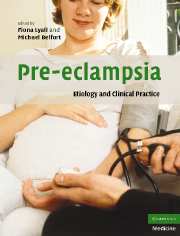Book contents
- Frontmatter
- Contents
- List of contributors
- Preface
- Part I Basic science
- Part II Clinical Practice
- 17 Classification and diagnosis of pre-eclampsia
- 18 Measuring blood pressure in pregnancy and pre-eclampsia
- 19 Immune maladaptation in the etiology of pre-eclampsia; an updated epidemiological perspective
- 20 Genetics of pre-eclampsia and counseling the patient who developed pre-eclampsia
- 21 Thrombophilias and pre-eclampsia
- 22 Medical illness and the risk of pre-eclampsia
- 23 The kidney and pre-eclampsia
- 24 Management of mild pre-eclampsia
- 25 Management of severe pre-eclampsia
- 26 The differential diagnosis of pre-eclampsia and eclampsia
- 27 Complications of pre-eclampsia
- 28 Central nervous system findings in pre-eclampsia and eclampsia
- 29 Pathogenesis and treatment of eclampsia
- 30 Anesthesia for the pre-eclamptic patient
- 31 Critical care management of severe pre-eclampsia
- 32 The role of maternal and fetal Doppler in pre-eclampsia
- 33 Pregnancy-induced hypertension – the effects on the newborn
- 34 Medico-legal implications of the diagnosis of pre-eclampsia
- Subject index
- References
32 - The role of maternal and fetal Doppler in pre-eclampsia
from Part II - Clinical Practice
Published online by Cambridge University Press: 03 September 2009
- Frontmatter
- Contents
- List of contributors
- Preface
- Part I Basic science
- Part II Clinical Practice
- 17 Classification and diagnosis of pre-eclampsia
- 18 Measuring blood pressure in pregnancy and pre-eclampsia
- 19 Immune maladaptation in the etiology of pre-eclampsia; an updated epidemiological perspective
- 20 Genetics of pre-eclampsia and counseling the patient who developed pre-eclampsia
- 21 Thrombophilias and pre-eclampsia
- 22 Medical illness and the risk of pre-eclampsia
- 23 The kidney and pre-eclampsia
- 24 Management of mild pre-eclampsia
- 25 Management of severe pre-eclampsia
- 26 The differential diagnosis of pre-eclampsia and eclampsia
- 27 Complications of pre-eclampsia
- 28 Central nervous system findings in pre-eclampsia and eclampsia
- 29 Pathogenesis and treatment of eclampsia
- 30 Anesthesia for the pre-eclamptic patient
- 31 Critical care management of severe pre-eclampsia
- 32 The role of maternal and fetal Doppler in pre-eclampsia
- 33 Pregnancy-induced hypertension – the effects on the newborn
- 34 Medico-legal implications of the diagnosis of pre-eclampsia
- Subject index
- References
Summary
Introduction
Fitzgerald and Drumm (1997), using a combination of real-time imaging, pulsed wave and continuous wave Doppler, first reported the use of flow velocity waveforms (FVW) from the umbilical cord in 1977. Since then the value of umbilical artery (UA) Doppler to assess fetal wellbeing has been investigated extensively; indeed, no other tool in perinatal medicine has received such rigorous appraisal in the form of randomized controlled trials. Subsequent studies have investigated other fetal arterial and venous vessels and although a significant body of literature now exists, especially for the middle cerebral artery (MCA) and ductus venosus (DV), the absence of appropriately powered randomized trials makes the clinical utility of these investigations unclear.
Of all the clinical groups labeled as “high risk,” women with pre-eclampsia and those at risk of developing the syndrome are probably those in which Doppler ultrasound has proven the greatest value. However, interpretation of the literature is often confounded by variations in the definition of the disorder. In this chapter we review the role of Doppler in screening and management of pre-eclampsia, focusing on uterine artery, UA, MCA and DV waveforms. Wherever possible an attempt will be made to distinguish between early onset (necessitating delivery before 34 weeks of gestation) and later disease.
Waveform acquisition and interpretation
Waveform indices
Measurement of absolute blood flow is dependent on multiple factors including angle of insonation, blood viscosity, and vessel diameter. The latter is difficult to measure and precludes accurate assessment of volume flow, especially in small fetal vessels.
- Type
- Chapter
- Information
- Pre-eclampsiaEtiology and Clinical Practice, pp. 489 - 505Publisher: Cambridge University PressPrint publication year: 2007



